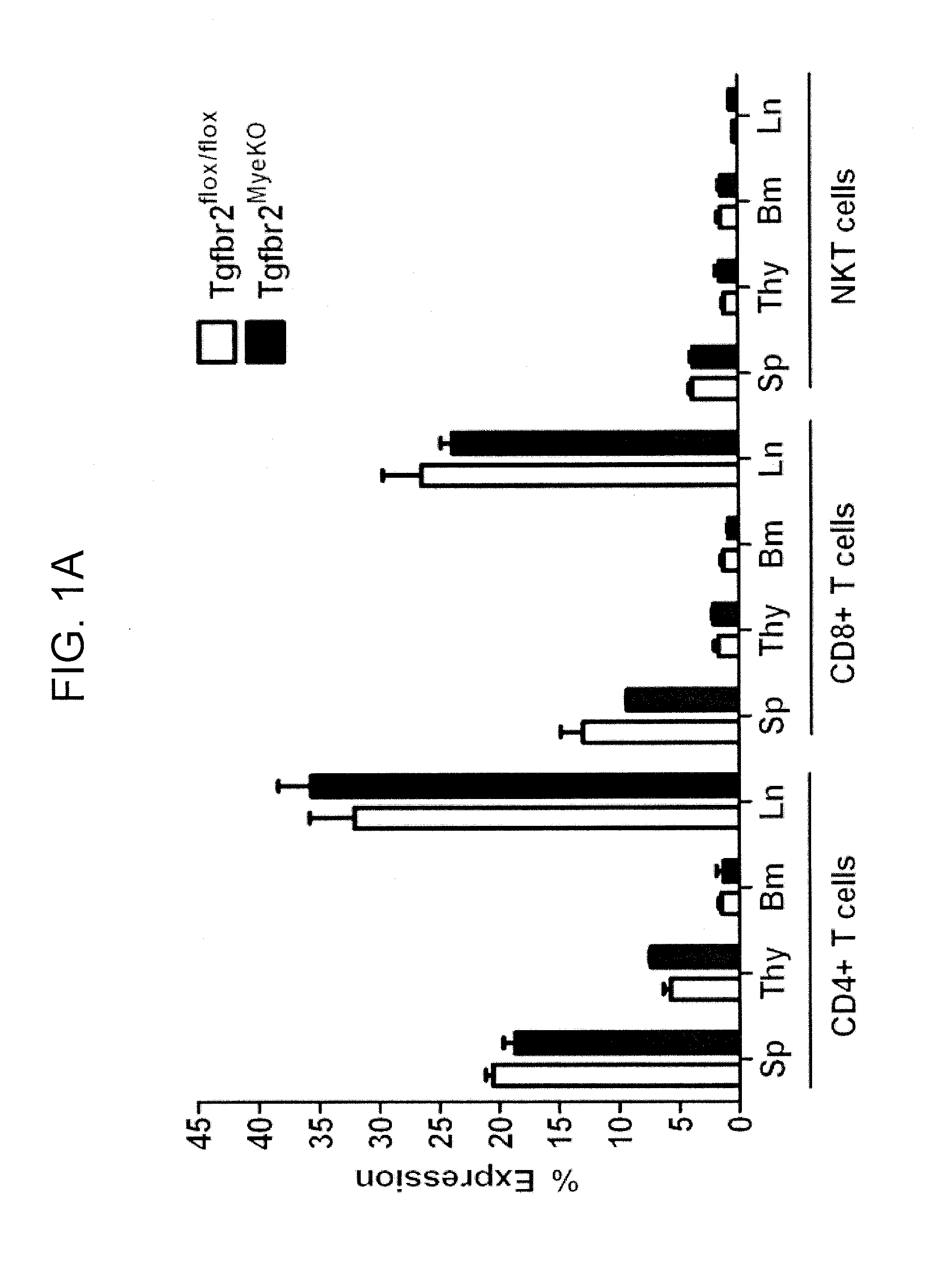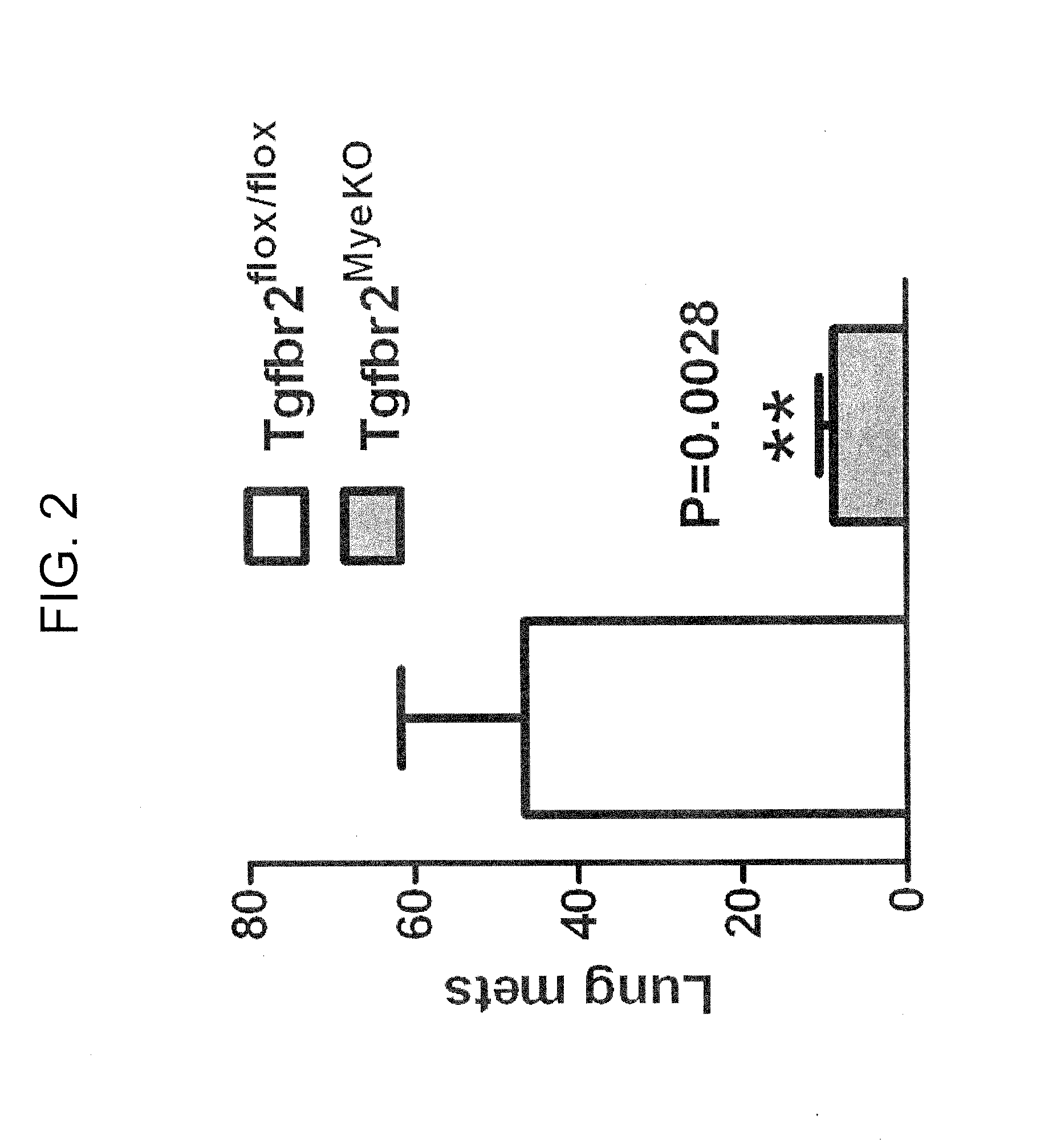Reduction of tgf beta signaling in myeloid cells in the treatment of cancer
a technology of myeloid cells and tgf beta, which is applied in the direction of dna/rna fragmentation, unknown materials, fungi, etc., can solve the problems of limited success of gene therapy, damage to normal cells, and non-selective cancer therapeutic approaches, and achieves the effects of inhibiting metastasis, reducing tgf signaling, and inhibiting metastasis in cancer patients
- Summary
- Abstract
- Description
- Claims
- Application Information
AI Technical Summary
Benefits of technology
Problems solved by technology
Method used
Image
Examples
example 1
[0060]This example demonstrates the generation of a myeloid-specific TGFβ receptor II knockout mouse.
[0061]Myeloid cells play an important role in tumor progression. They suppress host immune surveillance and influence the tumor microenvironment (see, e.g., Gabrilovich et al., Nat. Rev. Immunol., 9: 162-174 (2009); Pollard, Nat. Rev. Immunol., 9: 259-270 (2009); Mantovani, Nature, 457: 36-37 (2009), Fridlender et al., Cancer Cell, 16: 183-194 (2009); Balkwill et al., Nature, 431: 405-406 (2004), Yang et al., Cancer Cell, 6: 409-421 (2004); and Yang et al., Cancer Cell, 13: 23-35 (2008)). Myeloid cells are also present in the lungs prior to tumor cell arrival and contribute to pre-metastatic niche formation and environment alteration (see Kaplan et al., Nature, 438: 820-827 (2005); and Yan et al., Cancer Res., 70: 6139-6149 (2010)). These include tumor-associated macrophages (TAM, Mac-1+ or F4 / 80+ cells), Gr-1+CD11b+ cells or myeloid derived suppressor cells (MDSCs), and tumor associ...
example 2
[0063]This example demonstrates that reduced expression of TGFβ signaling reduces lung metastasis.
[0064]The 4T1 mammary tumor model shares many characteristics with human breast cancer, particularly its ability to spontaneously metastasize to the lungs. In an orthotopic metastasis design, 5×104 4T1 cells in 50 μL PBS were injected into the #2 mammary fat pad (MFP) of Tgfbr2MyeKO and floxed control Tgfbr2flox / flox mice. Mice were sacrificed 28 days later, and the number and size of lung metastasis was evaluated. Tgfbr2MyeKO mice showed a decreased ability to support tumor metastasis after injection of 4T1 mammary tumor cells (see FIG. 2), with no difference in primary tumor size.
[0065]In an experimental metastasis design, 2×105 4T1 cells were injected into the tail vein of Tgfbr2MyeKO and foxed control Tgfbr2flox / flox mice. The size of tumors was determined by direct measurement of tumor dimensions at 2-3 day intervals using calipers. The number of lung metastasis was evaluated when ...
example 3
[0067]This example demonstrates that the inventive methods inhibit metastasis.
[0068]To further confirm the inhibitory effect of myeloid-specific Tgfbr2 deletion on tumor metastasis, Tgfbr2MyeKO bone marrow (B.M.) was transplanted into wild-type mice bearing 4T1 tumors. 5×105 4T1 cells were injected into the #4 MFP on day 0. To better model clinical metastatic disease the primary tumor was surgically removed on day 15 and metastasis allowed to continue until day 34 allowing the mice to develop tumor invasion and metastasis. On day 34, the mice were irradiated and subjected to B.M. transplantation from either Tgfbr2MyeKO mice or Tgfbr2flox / flox control mice. Lung metastases were examined on day 63 and thereafter (see FIG. 5).
[0069]100% survival of the mice that received B.M. from the Tgfbr2MyeKO mice was observed, whereas approximately 55% of the mice that received B.M. from Tgfbr2f1ox / flox control mice exhibited decreased survival (see FIG. 6A). In addition, a significantly reduced n...
PUM
| Property | Measurement | Unit |
|---|---|---|
| Nucleic acid sequence | aaaaa | aaaaa |
Abstract
Description
Claims
Application Information
 Login to View More
Login to View More - R&D
- Intellectual Property
- Life Sciences
- Materials
- Tech Scout
- Unparalleled Data Quality
- Higher Quality Content
- 60% Fewer Hallucinations
Browse by: Latest US Patents, China's latest patents, Technical Efficacy Thesaurus, Application Domain, Technology Topic, Popular Technical Reports.
© 2025 PatSnap. All rights reserved.Legal|Privacy policy|Modern Slavery Act Transparency Statement|Sitemap|About US| Contact US: help@patsnap.com



